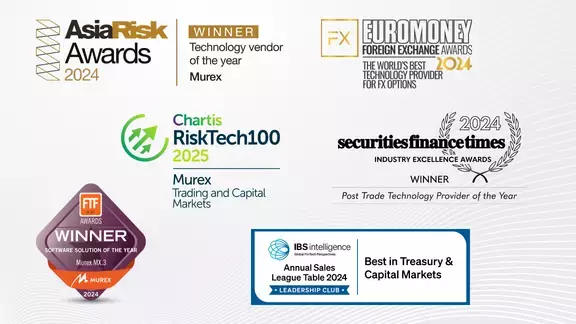-
Our solutions
- Our clients

With 300 clients and 60,000 users spread across 60 countries around the world, Murex has a truly international client base of capital markets participants.
view all case studies- Insights
- Who we are

Our awards highlight a strong level of customer satisfaction and acknowledge our market expertise.
Visit our awards webpage- Our partners
- Careers
Digital Transformation for Energy and Commodity Trading Efficiency: Streamlining Financial Derivatives Operations
by Gautham Chari, business development, Murex
An International Energy Agency report on AI published this year indicates global electricity consumption by data centers is projected to more than double to around 945 TWh by 2030. This represents up to 6 percent of total global demand when AI-related costs are accounted for. Driven by AI adoption, the U.S. economy could consume more electricity for data processing by 2030 than it does to manufacture all energy-intensive goods combined, including aluminum, steel, cement and chemicals.
Despite the transformative impact of digital technologies on energy consumption, energy sector adoption of digital technologies for transforming its operations has been sluggish, sometimes due to entrenched legacy systems or resistance to change. But faced with rising renewable integration and data revolution, the energy sector is rewriting its playbook. As digitalization drives both energy demand and efficiency, decision-makers—CTOs, CIOs, heads of trading, and risk leads—have the opportunity to steer their organizations into a digital future.
This opportunity is particularly interesting within financial derivatives trading in the energy and commodities business, where surging data volumes and rapid market shifts demand workflows that prioritize adaptability over rigidity. With global energy product derivatives projected to reach a nominal value of USD 48.41 trillion in 2025 and projected to grow at a compound annual rate of 2.84 percent through 2029, the case for streamlined operations has never been stronger, especially as overall commodity markets are expected to see nominal value growth driven by factors like energy transition demands and geopolitical shifts.
In a first article in a Murex series on energy and commodities, we examined the need for real-time risk aggregation amid geopolitical disruptions. This article advances the series by exploring how digitalization helps address entrenched inefficiencies within financial derivatives trading in the U.S. energy and commodities market. Let’s begin by defining the buzzword.
What is digital transformation?
Digital transformation in financial derivatives trading refers to the strategic integration of advanced technologies into unified, open frameworks that encompass trading, risk, operations and compliance across multi-asset, multi-currency portfolios.
It transcends basic digitization or process optimization by fundamentally reshaping how derivatives—from simple forwards and futures to exotic structures like accumulators, swings, and bespoke commodity-linked payoffs—are onboarded, hedged, speculated upon and optimized amid energy market volatility, supply shocks and the shift toward renewables and sustainable fuels. This transformation addresses legacy constraints like fragmented systems and manual workflows. At the same time, straight-through processing (STP) rates are improved via automated validation, payments, and document matching. It further supports flexible configurations, customizable workflows, pre-deal controls for price and credit risks, collateral management with dispute resolution, and reporting for regulations like EMIR, MiFID, and REMIT. Ultimately, it drives efficiency, reducing costs through data-driven decision-making and minimized errors, fostering innovation in cross-commodity transactions and energy transition-related derivatives. Regulatory requirements become competitive advantages for continuous evolution in dynamic markets.
Confronting legacy constraints
Financial derivatives serve as the backbone for hedging and optimization in energy markets, yet persistent inefficiencies undermine their potential. As of mid-2025, manual processes in trade capture, validation and settlement continue to plague energy and commodity trading firms, amplifying errors during intraday spikes triggered by supply shocks. STP rates in commodities and energy trading remain stagnant. Commodity traders have been slower than other industries to digitalize processes and adopt new workflow tools. They are hampered by fragmented systems that struggle with an industry expected to grow at 8.2 percent projected CAGR between 2025-2034 in commodity market nominal value. This growth is driven by growing demand for renewables and AI-integrated grids that translate into rising commodity trade flows, inflation hedging and expanded retail participation.
Another hurdle is integrating modern solutions with legacy systems. This can be complex and costly due to integration challenges with legacy systems. Large utilities and trading houses often rely on outdated core systems that are not designed to handle today's data volumes or interconnectivity. This can lead to data silos, inefficient workflows and a lack of seamless communication between old and new systems.
As the energy sector grapples with these inefficiencies, it is clear that a new approach is needed. The status quo of manual processes, fragmented systems, and outdated legacy infrastructure is no longer tenable. To unlock the full potential of financial derivatives and stay ahead of the curve, energy and commodity trading firms must rewrite their playbook. By harnessing the power of digitalization and cutting-edge technologies, firms can streamline processes, boost efficiency and future-proof their operations.
Enhancing efficiency: From fragmentation to adaptive integration
Digital transformation bridges operational silos by fostering interconnected systems that dynamically adapt to market demands. This year in the commodity derivatives segment, we see a demand for structured commodity products, drawing new clients toward advanced hedging and speculative tools.
Adopting a digitalization strategy offers streamlined operations through rapid instrument onboarding via comprehensive catalogs and preconfigured practices, while enabling precise bespoke payoff designs. This agility helps to seize opportunities as strategies shift, supporting exotic commodity-linked derivatives or refined offerings without compromising control or compliance.
Such efficiency gains also improve real-time risk management and portfolio oversight within firms where traders monitor intraday exposures and liquidity amid heightened scrutiny. Hybrid market risk architectures that decouple computations from databases and leverage cloud scalability deliver faster pricing, transparent calculations and minimal contention during peaks. This enables instant assessments, stress scenarios and proactive adjustments for both legacy and novel portfolios.
Further, reduced time-to-market emphasizes flexibility, with systems capturing diverse payoffs through customizable workflows, instrument configurations and data model extensionally deployable via CI/CD without binary changes.
Strategically, digitalization helps consolidate operations, enhance oversight and facilitate market expansion. It boosts client engagement, trading growth, innovation and competitive differentiation.
Murex’s MX.3 platform exemplifies these capabilities by serving as a unified, open framework. MX.3 seamlessly integrates trading, risk, collateral, and operations management, addressing the core challenges of fragmentation and legacy constraints in energy and commodity markets. Its comprehensive product catalog and preconfigured market practices accelerate onboarding of new instruments. Institutions can rapidly deploy a wide range of payoffs—from simple forwards and futures to exotics like accumulators and swings—while handling multi-commodity, multi-currency portfolios across entities. For bespoke needs, the flex framework and user payoff language empower clients to design and deploy tailored commodity payoffs with speed and precision, fostering innovation without disrupting existing workflows.
The hybrid market risk architecture ensures scalable, efficient computations for volatility management. It delivers real-time VAR, PAR, and credit limits, alongside instant positions, P&L, exposures and sensitivities. Flexible configurations and customizable workflows support seamless adaptations, with built-in event alerts for actualization, nomination, delivery, and settlement, all while improving STP rates. Broader integration aids operational consolidation, risk oversight, and market ventures—such as pre-deal limit controls for price and credit risks, collateral management with dispute resolution, and a flexible reporting engine for EMIR, MiFID, and REMIT compliance.
Digital transformation brings strategic value
In a time when inefficiencies can sometimes heighten operational challenges and limit flexibility, digital transformation is reshaping the field, creating more reliable and adaptable approaches for energy and commodity trading firms. Platforms like MX.3 serve as helpful examples of this shift, showing how smooth integration can enhance existing risk management practices while opening up opportunities for greater efficiency, growth and fresh ideas. By replacing disjointed systems and easing legacy limitations with a natively front-to-back integrated platform, MX.3 helps organizations move through the nuances of changing markets with greater ease, transforming possible challenges into helpful strengths. As we turn to our upcoming discussion on regulatory expertise, it's clear that adoption of digitalization as a strategic pillar offers energy and commodities firms a platform for growth, essential support for ongoing compliance and standing out in a more linked global setting.
Commodity market growth source: https://www.globalgrowthinsights.com/market-reports/derivatives-market-102850
You might be interested in ...
- Our clients


